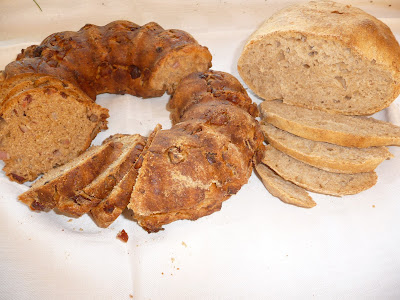
Bread is a mainstay of our occidental culture. Besides figuring prominently in Christian liturgies, it is the essential component of a meal: before plates became the rule, a slice of bread was a good substitute. Pâté was originally meat enclosed in bread. A brief analysis of the words derived from “bread” and “loaf” in our language indicates how crucial its role is in society: lord (Anglo-Saxon hlaford) means the master who supplies the loaf and lady (hlaefdige) the person who kneads the loaf. Company comes from the Latin companio, those who share bread (pane). In ancient times villages were built around a communal exterior oven, a well and a church.
Bread (especially leavened) is one of the wonders of the kitchen. Its transformative powers appear almost magical. The flour mixed with water when left outside for a couple of day will double in volume and cook to a crusty outside and crumbly internal structure. What is responsible for the metamorphosis is the addition of water causing the two components of flour, gluten proteins and starch granules, to react and become alive. The first recipe given to me by my friend Karen, builds on this slow rising process. It requires patience, as the leavening time takes 24 hours. Incidentally a version of the same recipe appeared in a recent New York Magazine issue under the name Pane Integrale. There are several advantages to the usage of this technique: no kneading is necessary, less yeast is used and the bread is very digestible and tasty. To encourage the final rise during the first 10 minutes of the 35 it takes to bake the bread, it helps to add some steam. To do so, just add ice cubes in the oven along with the bread.
Kugloff, (this is the Alsatian form, one of many spellings) is a form of bread favored in Central Europe. I like the savory kind rather than the sweet brioche. It is traditionally cooked in the turban like mold we call bund in the United States. I like to think its shape alludes to its Turkish origins : the Ottoman Empire was barely stopped in its progression in front of Vienna. It is a great addition to a buffet table.
Karen’s bread (Easy, Rising and prep: 24 hours, Cooking time : 35 minutes, Cheap)
Ingredients:
3 cups flour (2 cups ¼ unbleached bread flour ¾ cup whole wheat)
¼ teaspoon Instant dry yeast
1¼ teaspoon salt
1½ cups water
Ice cubes
Material
Wooden spoon
Salad bowl
Clean towel
Ovenproof container
Cookie sheet
Place the flour in the salad bowl. Add the salt and dry yeast. Pour the water and mix until moistened and shaggy looking. The dough should be on the wet side: if not add a little water. Cover with a clean towel.
Forget for 24 hours. The bread should have doubled in volume. Place the towel on the counter and sprinkle with flour.
Briefly knead the bread and shape into a round country loaf. Fold loosely with the towel and let rise for the second time for another 1 to 2 hours.
Preheat the oven at 450F (220C) with the cookie sheet positioned in its lower tier for 30 minutes. When the temperature of the oven has reached the set heat, add the ice cubes in an ovenproof container and the bread on a parchment paper on to the cookie sheet.
Bake for 35 minutes.
Savory Kugloff
(Easy, Preparation and cooking time: 3 hours partly unattended, Cheap)
Ingredients:
4 cups (500g) flour
1 envelope fast rising yeast or 1 cube fresh yeast
2/3 cup (100g) softened butter
2-3 tablespoons (30 g) sugar
1 cup (225ml) milk boiled and then cooled
1/2 teaspoon salt
2 whole eggs
1/2 pound (250g) smoked bacon, chopped
3 tablespoons chestnuts, coarsely chopped
Material:
Food processor with the dough hook on
Sillicone spoon
Bund cake pan
Ice cubes in an ovenproof container
Put the flour in your food processor and add the eggs and the yeast. Mix them quickly with the flour and let it rest for ten minutes.
Add the salt and the milk, and mix well. Beat in the softened butter. Add the chopped bacon and chopped chestnuts. Beat with the dough hook or with a wooden spoon for about five minutes. Cover the bowl and let it rise for about twenty minutes.
Butter the cake pan extremely well, being careful not to miss the deep grooves in any of the flutings. Spoon the dough into the mold, even out the top, and allow to rise for about an hour and a half, or until even with the top of the mold.
Preheat the oven to 400° F (220C).
Bake the loaf along with the ice cube container in the center of the oven for approximately 40 minutes. When done, remove and cool in its mold for 15-20 minutes before turning out on a rack to cool.
Serve slightly warm as an appetizer or snack with wine.




No comments:
Post a Comment